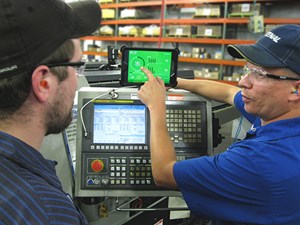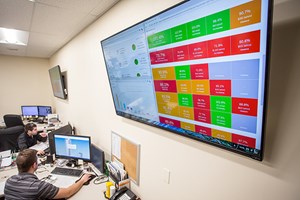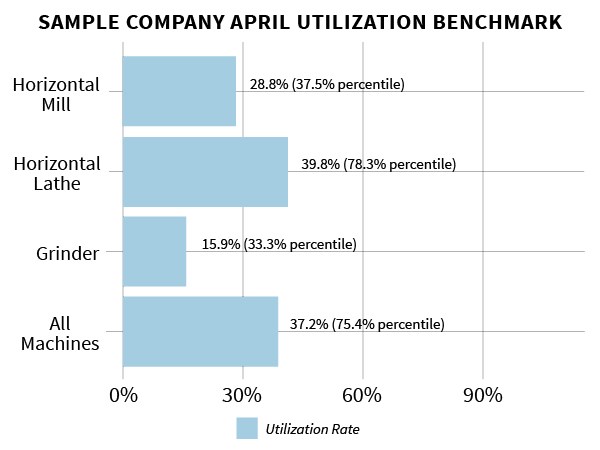Increase Efficiency with Solution-Focused Machine Monitoring
Sponsored ContentMachineMetrics provides an IIoT platform that on average improves productivity 25 percent in the first month by automatically interpreting and acting on machine data.
Share
How would you like your machine tool to not only keep track of cutting-tool wear, but to automatically change out dull tools to keep throughput from dropping? Or how about having your computer system automatically schedule preventative maintenance to avoid drops in performance? What if your computer network could not only identify production bottlenecks, but also provide suggested solutions?
Can data-driven manufacturing really accomplish this?
Entering into Industry 4.0 with Data-Driven Machining

MachineMetrics provides Industry 4.0 solutions beyond machine monitoring.
As Industry 4.0 and the Industrial Internet of Things (IIoT) steadily integrate into the world of manufacturing, many plant managers are wondering if the benefits are worth the investment. After all, an engineer will want hard, tangible results, and something as nebulous and abstract as data might not seem concrete enough to invest in. However, nothing provides more opportunities to improve your business than actionable information.
Information is at the heart of what IIoT offers manufacturers, and machine monitoring is the first step into that world. While most plant managers try to keep track of machine uptime, even the simplest monitoring system takes the guesswork out of the process. Instead, the user can know precisely how long machines take to finish a part, how much downtime a machine has and more. Uptime tracking alone provides numerous benefits.
For instance, identifying where machine downtime is creating a bottleneck in production creates the opportunity for machine shops to make process improvements in the areas likely to yield the greatest benefit. Additionally, keeping hard data on machine uptime enables manufacturers to accurately measure and track the success of improvements made.
Unfortunately, many shops struggle to implement Industry 4.0 solutions. According to MachineMetrics, the provider of IIoT solutions, half of U.S. companies admit to not having a systematic roadmap for implementing data management or the IIoT. Furthermore, many struggle to make use of what can seem like an overwhelming amount of data. Fortunately, Graham Immerman of MachineMetrics says that modern IIoT systems do more than simply provide data, they provide the tools that make data useful.

MachineMetrics not only monitors machines, but also identifies warning states and is capable of automated adjustments.
Meaningful Data Brings Concrete Solutions
According to Immerman, machine monitoring is only the first step towards true data-driven manufacturing. Rather than simply accumulating data, MachineMetrics Production analyzes the data to show where and how the shop can improve efficiency. The system provides real-time notifications that enable manufacturers to quickly respond when the software identifies areas of reduced efficiency, and it is even capable of automated decision making. “We can install sensors in production equipment that feed information our software can use to make decisions within defined parameters.” That means that the information sensors feed back to the software is acted upon. MachineMetrics’ software can schedule maintenance, shut down machines before failures create scrap, and change out cutting tools to optimize performance.
Additionally, MachineMetrics software can schedule machine upkeep and job changeover to reduce overlap between machines, avoiding excess downtime. In addition to keeping the costs down, this can enable shopfloor workers to make the best use of their time, avoiding frustrating slowdowns due to work piling up all at once. Eliminating downtime is no longer about manually pouring through data, but rather letting your system react to the data it collects.
Predicting Success with Predictive Maintenance

MachineMetrics software can schedule machine upkeep and job changeover to reduce overlap between machines, avoiding excess downtime.
MachineMetrics is even equipped with out-of-the-box access to predictive maintenance. This enables the system to schedule preventative maintenance before wear can cause major failures that lead to reworked or scrapped parts. It further increases productivity by keeping machines running at optimal levels. “We have improved efficiency in some shops by as much as 40-to-50 percent,” Immerman says. “Our software not only identifies potential failures, but it also schedules repairs and services during scheduled downtime to keep machines running as much as possible.”
This system provides benefits at all levels of production. It provides shopfloor workers with access to dynamic alerts that keep them informed of the status of every job they oversee. Shop managers can greatly benefit from access to realtime dashboards that provide immediate access to performance data across the facility. This encourages in-process approaches to problem solving, rather than waiting until scrapped parts or quality control lets you know trouble has arrived. At even higher levels, it enables operational visibility not only plant-wide, but across multiple facilities. The system can analyze production equipment to determine the root cause of production issues and make it available to every level of management so that the problem comes to the attention of the person who can handle it.

This sample chart not only shows a company’s machine utilization, but it also serves as a benchmarking tool, showing that the company performed better than 75.4% of MachineMetrics companies.
Machine monitoring is an important first step into the world of data-driven manufacturing, but it is only a first step. To fully realize the benefits of IIoT, a solutions-focused approach is necessary, and that is where MachineMetrics excels. Instead of overwhelming shops with mountains of information, the company’s automated data analysis provides them with paths forward.
For more information, visit MachineMetrics online.



